MG414 Organisational Behaviour Report: Sainsbury's Culture Analysis
VerifiedAdded on 2020/12/09
|11
|3160
|181
Report
AI Summary
This report provides an in-depth analysis of Sainsbury's organisational behaviour, focusing on its culture, communication strategies, and employee motivation. It begins with an executive summary and introduction, outlining the importance of organisational behaviour in achieving company success. The report then delves into Sainsbury's organisational culture, utilizing Handy's typology model to understand its structure and values. It explores motivation techniques, specifically Abraham Maslow's hierarchy of needs, and how Sainsbury applies them to encourage employees. The report examines communication within Sainsbury, highlighting its flat organisational structure and various communication channels. Further, it discusses the role of culture in improving organisational effectiveness, with a focus on communication, and evaluates the impact of culture on employee motivation using Theory X and Y. The report concludes by evaluating how Sainsbury could leverage its culture to further enhance its success, offering insights and recommendations based on the analysis.
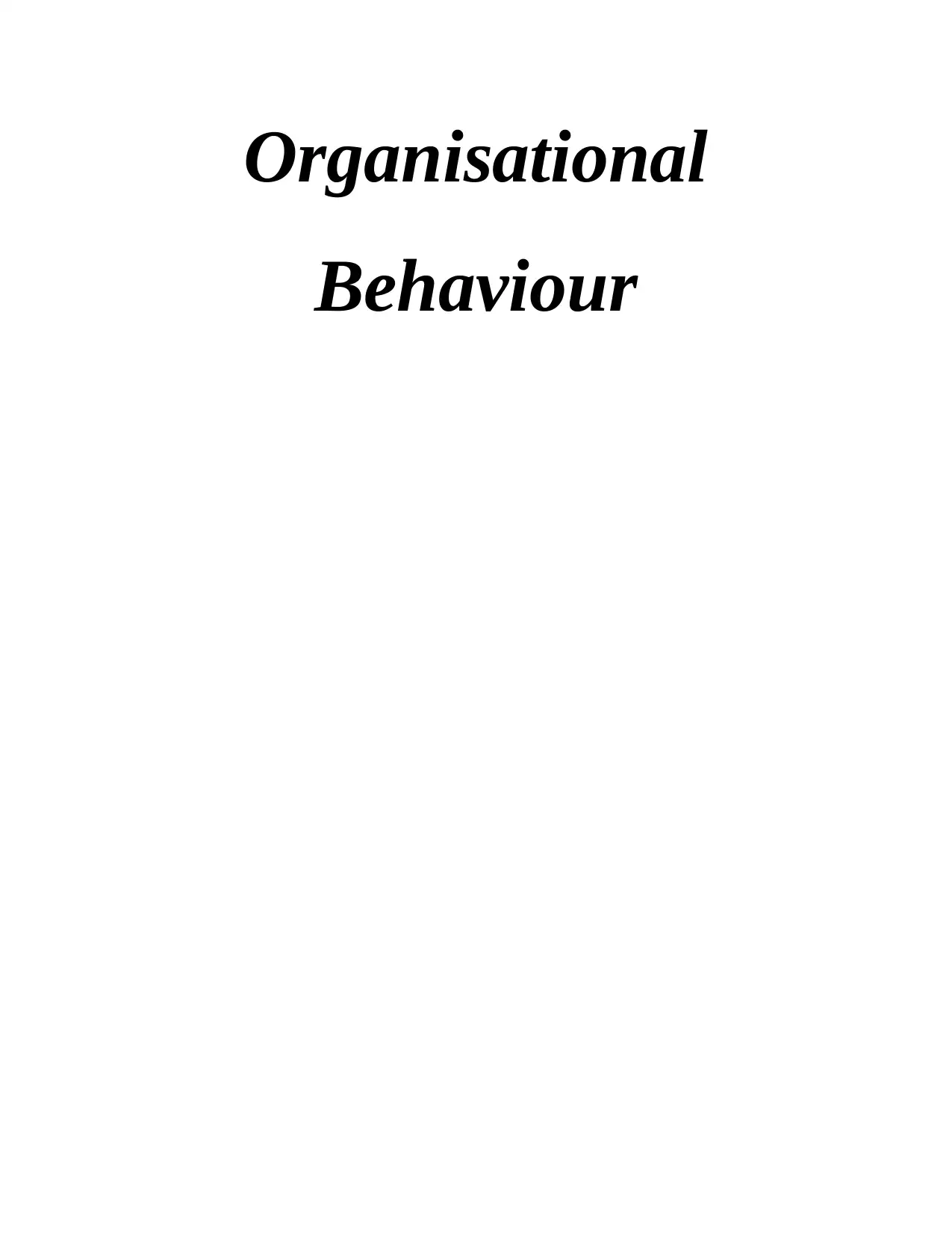
Organisational
Behaviour
Behaviour
Paraphrase This Document
Need a fresh take? Get an instant paraphrase of this document with our AI Paraphraser
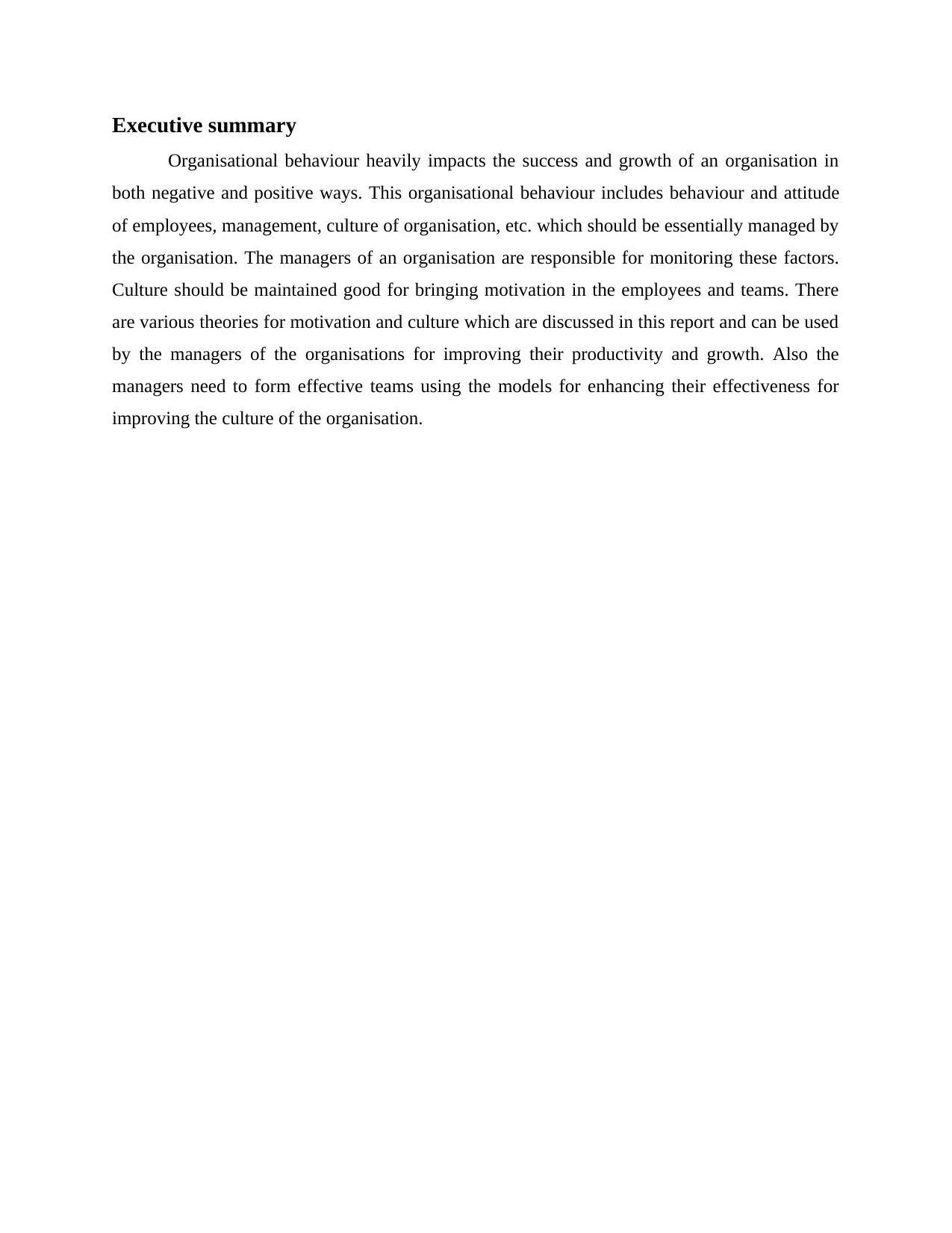
Executive summary
Organisational behaviour heavily impacts the success and growth of an organisation in
both negative and positive ways. This organisational behaviour includes behaviour and attitude
of employees, management, culture of organisation, etc. which should be essentially managed by
the organisation. The managers of an organisation are responsible for monitoring these factors.
Culture should be maintained good for bringing motivation in the employees and teams. There
are various theories for motivation and culture which are discussed in this report and can be used
by the managers of the organisations for improving their productivity and growth. Also the
managers need to form effective teams using the models for enhancing their effectiveness for
improving the culture of the organisation.
Organisational behaviour heavily impacts the success and growth of an organisation in
both negative and positive ways. This organisational behaviour includes behaviour and attitude
of employees, management, culture of organisation, etc. which should be essentially managed by
the organisation. The managers of an organisation are responsible for monitoring these factors.
Culture should be maintained good for bringing motivation in the employees and teams. There
are various theories for motivation and culture which are discussed in this report and can be used
by the managers of the organisations for improving their productivity and growth. Also the
managers need to form effective teams using the models for enhancing their effectiveness for
improving the culture of the organisation.
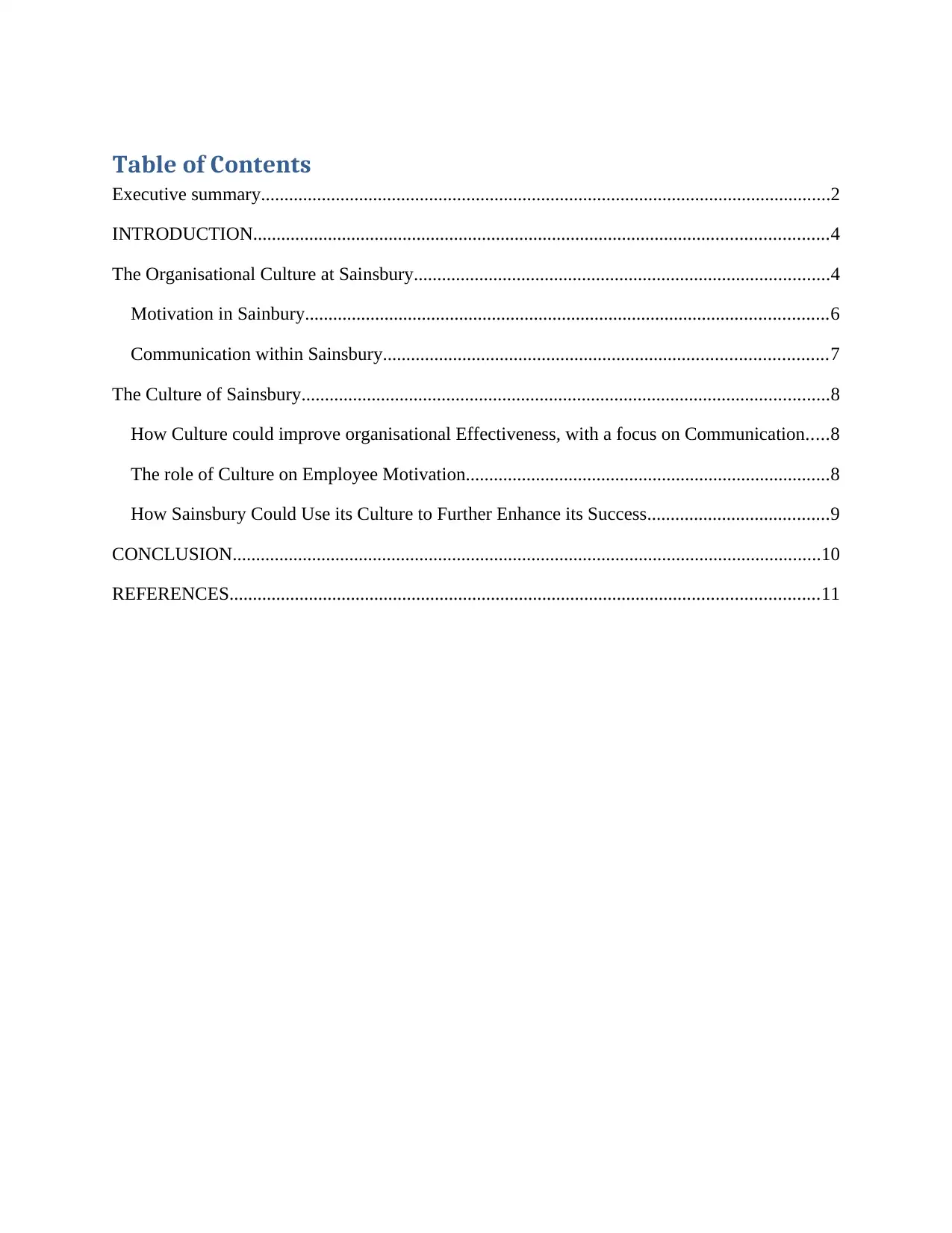
Table of Contents
Executive summary..........................................................................................................................2
INTRODUCTION...........................................................................................................................4
The Organisational Culture at Sainsbury.........................................................................................4
Motivation in Sainbury................................................................................................................6
Communication within Sainsbury...............................................................................................7
The Culture of Sainsbury.................................................................................................................8
How Culture could improve organisational Effectiveness, with a focus on Communication.....8
The role of Culture on Employee Motivation..............................................................................8
How Sainsbury Could Use its Culture to Further Enhance its Success.......................................9
CONCLUSION..............................................................................................................................10
REFERENCES..............................................................................................................................11
Executive summary..........................................................................................................................2
INTRODUCTION...........................................................................................................................4
The Organisational Culture at Sainsbury.........................................................................................4
Motivation in Sainbury................................................................................................................6
Communication within Sainsbury...............................................................................................7
The Culture of Sainsbury.................................................................................................................8
How Culture could improve organisational Effectiveness, with a focus on Communication.....8
The role of Culture on Employee Motivation..............................................................................8
How Sainsbury Could Use its Culture to Further Enhance its Success.......................................9
CONCLUSION..............................................................................................................................10
REFERENCES..............................................................................................................................11
⊘ This is a preview!⊘
Do you want full access?
Subscribe today to unlock all pages.

Trusted by 1+ million students worldwide
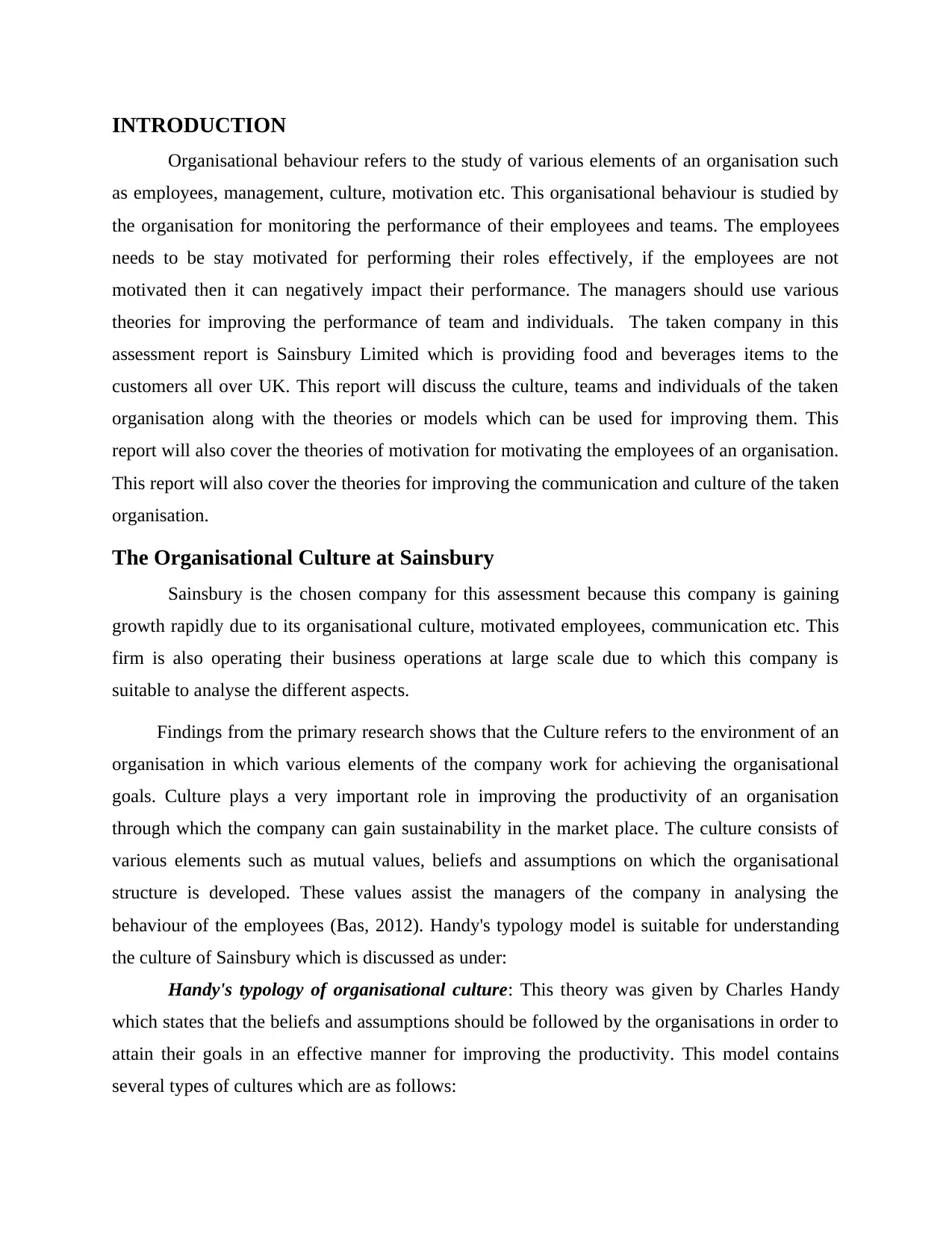
INTRODUCTION
Organisational behaviour refers to the study of various elements of an organisation such
as employees, management, culture, motivation etc. This organisational behaviour is studied by
the organisation for monitoring the performance of their employees and teams. The employees
needs to be stay motivated for performing their roles effectively, if the employees are not
motivated then it can negatively impact their performance. The managers should use various
theories for improving the performance of team and individuals. The taken company in this
assessment report is Sainsbury Limited which is providing food and beverages items to the
customers all over UK. This report will discuss the culture, teams and individuals of the taken
organisation along with the theories or models which can be used for improving them. This
report will also cover the theories of motivation for motivating the employees of an organisation.
This report will also cover the theories for improving the communication and culture of the taken
organisation.
The Organisational Culture at Sainsbury
Sainsbury is the chosen company for this assessment because this company is gaining
growth rapidly due to its organisational culture, motivated employees, communication etc. This
firm is also operating their business operations at large scale due to which this company is
suitable to analyse the different aspects.
Findings from the primary research shows that the Culture refers to the environment of an
organisation in which various elements of the company work for achieving the organisational
goals. Culture plays a very important role in improving the productivity of an organisation
through which the company can gain sustainability in the market place. The culture consists of
various elements such as mutual values, beliefs and assumptions on which the organisational
structure is developed. These values assist the managers of the company in analysing the
behaviour of the employees (Bas, 2012). Handy's typology model is suitable for understanding
the culture of Sainsbury which is discussed as under:
Handy's typology of organisational culture: This theory was given by Charles Handy
which states that the beliefs and assumptions should be followed by the organisations in order to
attain their goals in an effective manner for improving the productivity. This model contains
several types of cultures which are as follows:
Organisational behaviour refers to the study of various elements of an organisation such
as employees, management, culture, motivation etc. This organisational behaviour is studied by
the organisation for monitoring the performance of their employees and teams. The employees
needs to be stay motivated for performing their roles effectively, if the employees are not
motivated then it can negatively impact their performance. The managers should use various
theories for improving the performance of team and individuals. The taken company in this
assessment report is Sainsbury Limited which is providing food and beverages items to the
customers all over UK. This report will discuss the culture, teams and individuals of the taken
organisation along with the theories or models which can be used for improving them. This
report will also cover the theories of motivation for motivating the employees of an organisation.
This report will also cover the theories for improving the communication and culture of the taken
organisation.
The Organisational Culture at Sainsbury
Sainsbury is the chosen company for this assessment because this company is gaining
growth rapidly due to its organisational culture, motivated employees, communication etc. This
firm is also operating their business operations at large scale due to which this company is
suitable to analyse the different aspects.
Findings from the primary research shows that the Culture refers to the environment of an
organisation in which various elements of the company work for achieving the organisational
goals. Culture plays a very important role in improving the productivity of an organisation
through which the company can gain sustainability in the market place. The culture consists of
various elements such as mutual values, beliefs and assumptions on which the organisational
structure is developed. These values assist the managers of the company in analysing the
behaviour of the employees (Bas, 2012). Handy's typology model is suitable for understanding
the culture of Sainsbury which is discussed as under:
Handy's typology of organisational culture: This theory was given by Charles Handy
which states that the beliefs and assumptions should be followed by the organisations in order to
attain their goals in an effective manner for improving the productivity. This model contains
several types of cultures which are as follows:
Paraphrase This Document
Need a fresh take? Get an instant paraphrase of this document with our AI Paraphraser
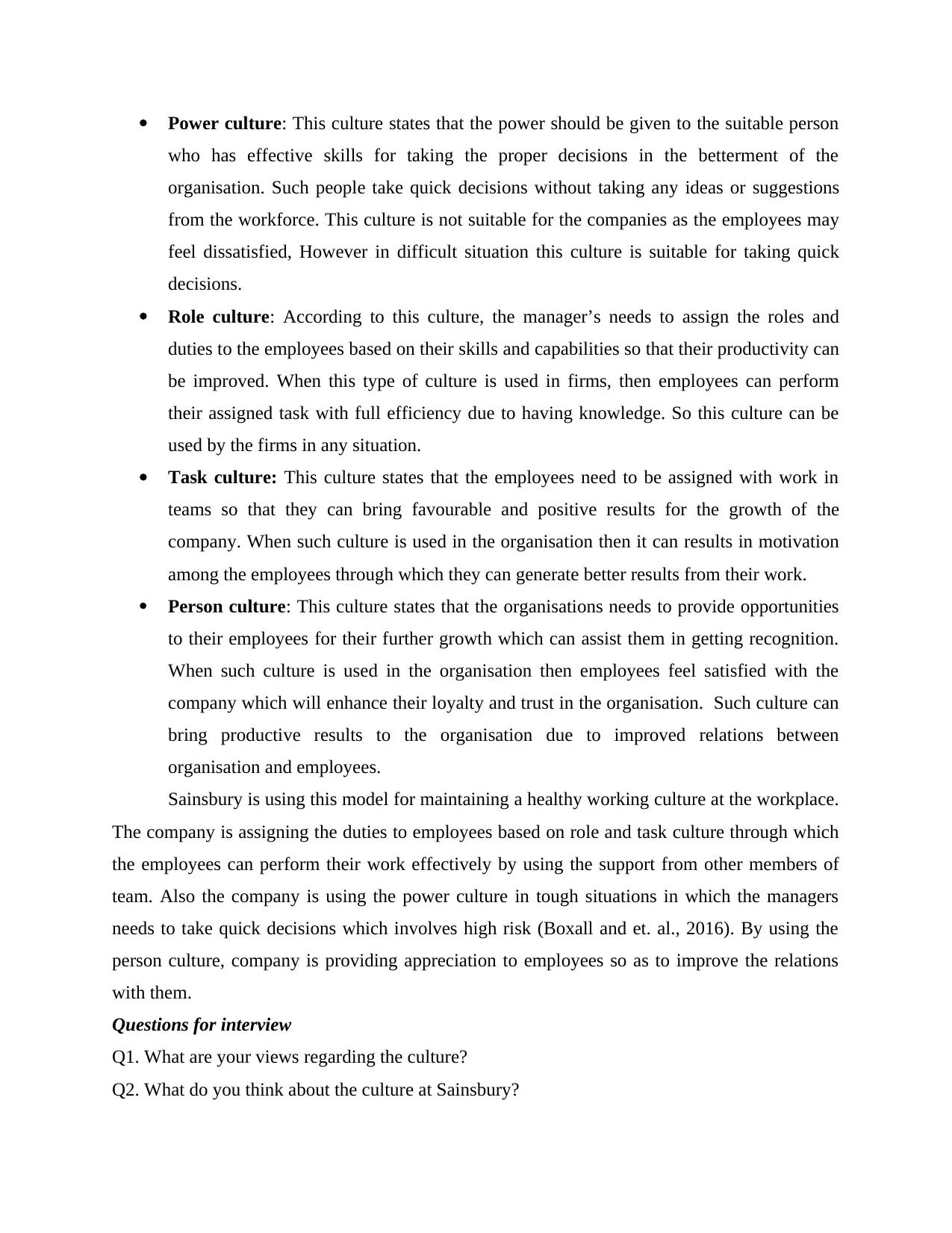
Power culture: This culture states that the power should be given to the suitable person
who has effective skills for taking the proper decisions in the betterment of the
organisation. Such people take quick decisions without taking any ideas or suggestions
from the workforce. This culture is not suitable for the companies as the employees may
feel dissatisfied, However in difficult situation this culture is suitable for taking quick
decisions.
Role culture: According to this culture, the manager’s needs to assign the roles and
duties to the employees based on their skills and capabilities so that their productivity can
be improved. When this type of culture is used in firms, then employees can perform
their assigned task with full efficiency due to having knowledge. So this culture can be
used by the firms in any situation.
Task culture: This culture states that the employees need to be assigned with work in
teams so that they can bring favourable and positive results for the growth of the
company. When such culture is used in the organisation then it can results in motivation
among the employees through which they can generate better results from their work.
Person culture: This culture states that the organisations needs to provide opportunities
to their employees for their further growth which can assist them in getting recognition.
When such culture is used in the organisation then employees feel satisfied with the
company which will enhance their loyalty and trust in the organisation. Such culture can
bring productive results to the organisation due to improved relations between
organisation and employees.
Sainsbury is using this model for maintaining a healthy working culture at the workplace.
The company is assigning the duties to employees based on role and task culture through which
the employees can perform their work effectively by using the support from other members of
team. Also the company is using the power culture in tough situations in which the managers
needs to take quick decisions which involves high risk (Boxall and et. al., 2016). By using the
person culture, company is providing appreciation to employees so as to improve the relations
with them.
Questions for interview
Q1. What are your views regarding the culture?
Q2. What do you think about the culture at Sainsbury?
who has effective skills for taking the proper decisions in the betterment of the
organisation. Such people take quick decisions without taking any ideas or suggestions
from the workforce. This culture is not suitable for the companies as the employees may
feel dissatisfied, However in difficult situation this culture is suitable for taking quick
decisions.
Role culture: According to this culture, the manager’s needs to assign the roles and
duties to the employees based on their skills and capabilities so that their productivity can
be improved. When this type of culture is used in firms, then employees can perform
their assigned task with full efficiency due to having knowledge. So this culture can be
used by the firms in any situation.
Task culture: This culture states that the employees need to be assigned with work in
teams so that they can bring favourable and positive results for the growth of the
company. When such culture is used in the organisation then it can results in motivation
among the employees through which they can generate better results from their work.
Person culture: This culture states that the organisations needs to provide opportunities
to their employees for their further growth which can assist them in getting recognition.
When such culture is used in the organisation then employees feel satisfied with the
company which will enhance their loyalty and trust in the organisation. Such culture can
bring productive results to the organisation due to improved relations between
organisation and employees.
Sainsbury is using this model for maintaining a healthy working culture at the workplace.
The company is assigning the duties to employees based on role and task culture through which
the employees can perform their work effectively by using the support from other members of
team. Also the company is using the power culture in tough situations in which the managers
needs to take quick decisions which involves high risk (Boxall and et. al., 2016). By using the
person culture, company is providing appreciation to employees so as to improve the relations
with them.
Questions for interview
Q1. What are your views regarding the culture?
Q2. What do you think about the culture at Sainsbury?
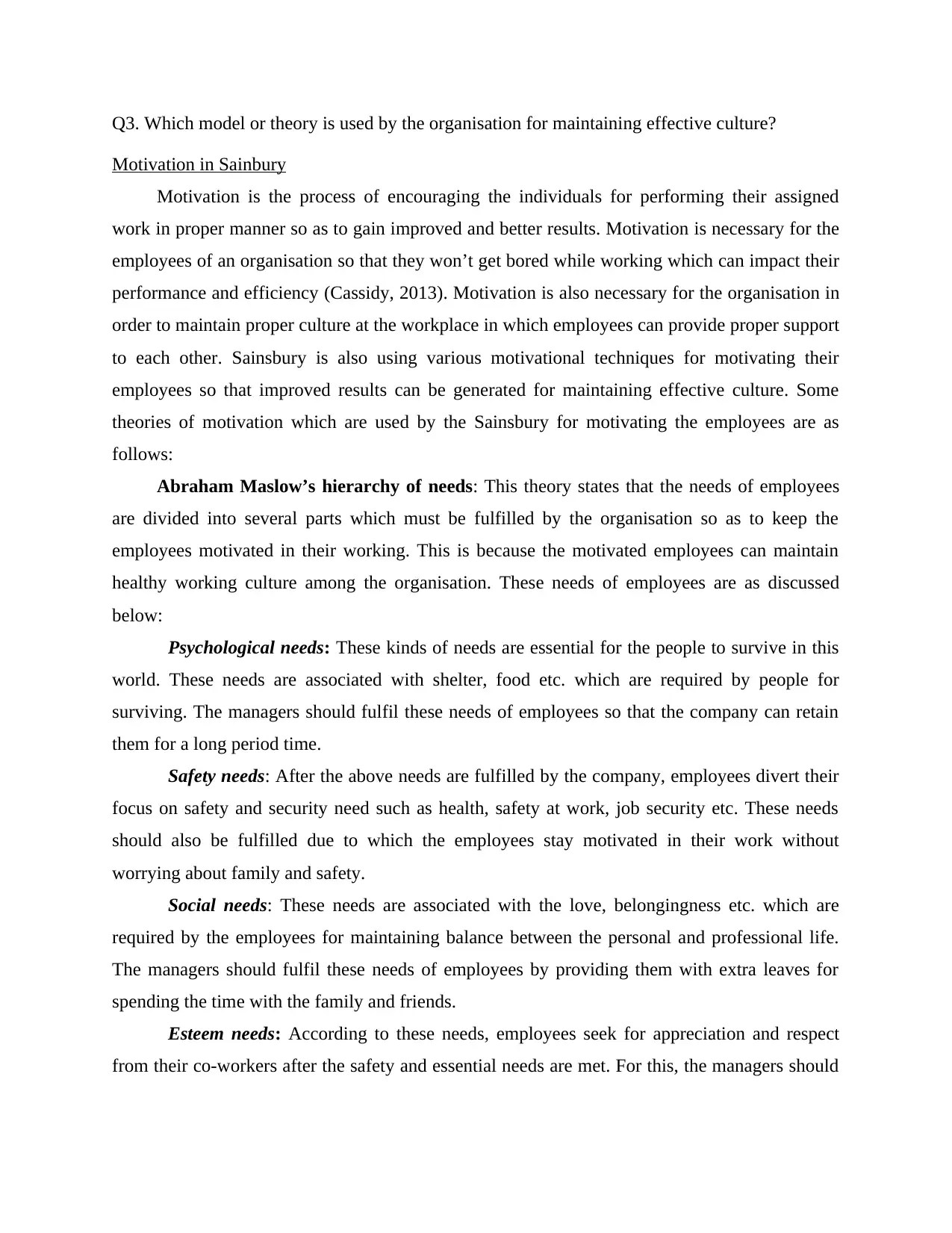
Q3. Which model or theory is used by the organisation for maintaining effective culture?
Motivation in Sainbury
Motivation is the process of encouraging the individuals for performing their assigned
work in proper manner so as to gain improved and better results. Motivation is necessary for the
employees of an organisation so that they won’t get bored while working which can impact their
performance and efficiency (Cassidy, 2013). Motivation is also necessary for the organisation in
order to maintain proper culture at the workplace in which employees can provide proper support
to each other. Sainsbury is also using various motivational techniques for motivating their
employees so that improved results can be generated for maintaining effective culture. Some
theories of motivation which are used by the Sainsbury for motivating the employees are as
follows:
Abraham Maslow’s hierarchy of needs: This theory states that the needs of employees
are divided into several parts which must be fulfilled by the organisation so as to keep the
employees motivated in their working. This is because the motivated employees can maintain
healthy working culture among the organisation. These needs of employees are as discussed
below:
Psychological needs: These kinds of needs are essential for the people to survive in this
world. These needs are associated with shelter, food etc. which are required by people for
surviving. The managers should fulfil these needs of employees so that the company can retain
them for a long period time.
Safety needs: After the above needs are fulfilled by the company, employees divert their
focus on safety and security need such as health, safety at work, job security etc. These needs
should also be fulfilled due to which the employees stay motivated in their work without
worrying about family and safety.
Social needs: These needs are associated with the love, belongingness etc. which are
required by the employees for maintaining balance between the personal and professional life.
The managers should fulfil these needs of employees by providing them with extra leaves for
spending the time with the family and friends.
Esteem needs: According to these needs, employees seek for appreciation and respect
from their co-workers after the safety and essential needs are met. For this, the managers should
Motivation in Sainbury
Motivation is the process of encouraging the individuals for performing their assigned
work in proper manner so as to gain improved and better results. Motivation is necessary for the
employees of an organisation so that they won’t get bored while working which can impact their
performance and efficiency (Cassidy, 2013). Motivation is also necessary for the organisation in
order to maintain proper culture at the workplace in which employees can provide proper support
to each other. Sainsbury is also using various motivational techniques for motivating their
employees so that improved results can be generated for maintaining effective culture. Some
theories of motivation which are used by the Sainsbury for motivating the employees are as
follows:
Abraham Maslow’s hierarchy of needs: This theory states that the needs of employees
are divided into several parts which must be fulfilled by the organisation so as to keep the
employees motivated in their working. This is because the motivated employees can maintain
healthy working culture among the organisation. These needs of employees are as discussed
below:
Psychological needs: These kinds of needs are essential for the people to survive in this
world. These needs are associated with shelter, food etc. which are required by people for
surviving. The managers should fulfil these needs of employees so that the company can retain
them for a long period time.
Safety needs: After the above needs are fulfilled by the company, employees divert their
focus on safety and security need such as health, safety at work, job security etc. These needs
should also be fulfilled due to which the employees stay motivated in their work without
worrying about family and safety.
Social needs: These needs are associated with the love, belongingness etc. which are
required by the employees for maintaining balance between the personal and professional life.
The managers should fulfil these needs of employees by providing them with extra leaves for
spending the time with the family and friends.
Esteem needs: According to these needs, employees seek for appreciation and respect
from their co-workers after the safety and essential needs are met. For this, the managers should
⊘ This is a preview!⊘
Do you want full access?
Subscribe today to unlock all pages.

Trusted by 1+ million students worldwide
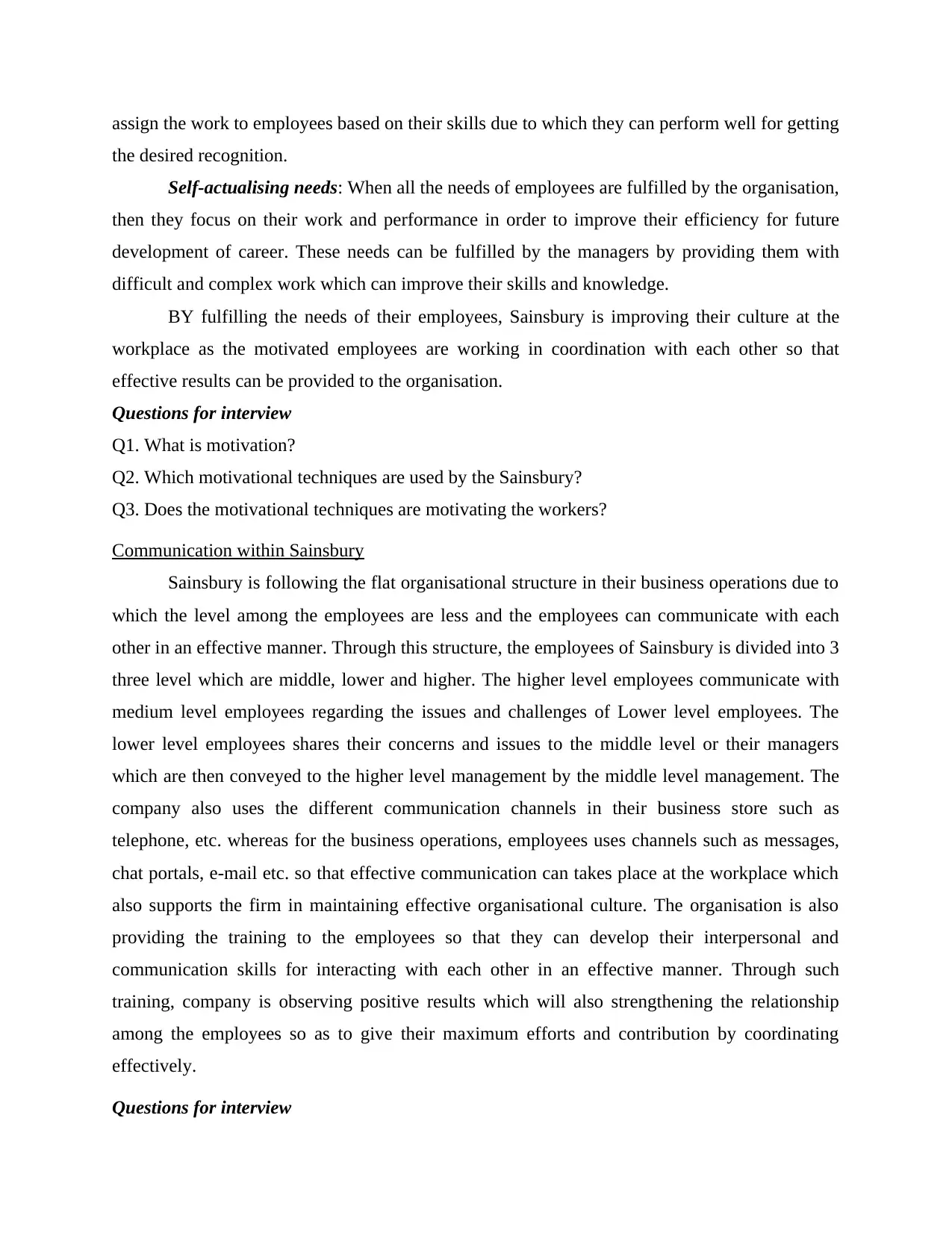
assign the work to employees based on their skills due to which they can perform well for getting
the desired recognition.
Self-actualising needs: When all the needs of employees are fulfilled by the organisation,
then they focus on their work and performance in order to improve their efficiency for future
development of career. These needs can be fulfilled by the managers by providing them with
difficult and complex work which can improve their skills and knowledge.
BY fulfilling the needs of their employees, Sainsbury is improving their culture at the
workplace as the motivated employees are working in coordination with each other so that
effective results can be provided to the organisation.
Questions for interview
Q1. What is motivation?
Q2. Which motivational techniques are used by the Sainsbury?
Q3. Does the motivational techniques are motivating the workers?
Communication within Sainsbury
Sainsbury is following the flat organisational structure in their business operations due to
which the level among the employees are less and the employees can communicate with each
other in an effective manner. Through this structure, the employees of Sainsbury is divided into 3
three level which are middle, lower and higher. The higher level employees communicate with
medium level employees regarding the issues and challenges of Lower level employees. The
lower level employees shares their concerns and issues to the middle level or their managers
which are then conveyed to the higher level management by the middle level management. The
company also uses the different communication channels in their business store such as
telephone, etc. whereas for the business operations, employees uses channels such as messages,
chat portals, e-mail etc. so that effective communication can takes place at the workplace which
also supports the firm in maintaining effective organisational culture. The organisation is also
providing the training to the employees so that they can develop their interpersonal and
communication skills for interacting with each other in an effective manner. Through such
training, company is observing positive results which will also strengthening the relationship
among the employees so as to give their maximum efforts and contribution by coordinating
effectively.
Questions for interview
the desired recognition.
Self-actualising needs: When all the needs of employees are fulfilled by the organisation,
then they focus on their work and performance in order to improve their efficiency for future
development of career. These needs can be fulfilled by the managers by providing them with
difficult and complex work which can improve their skills and knowledge.
BY fulfilling the needs of their employees, Sainsbury is improving their culture at the
workplace as the motivated employees are working in coordination with each other so that
effective results can be provided to the organisation.
Questions for interview
Q1. What is motivation?
Q2. Which motivational techniques are used by the Sainsbury?
Q3. Does the motivational techniques are motivating the workers?
Communication within Sainsbury
Sainsbury is following the flat organisational structure in their business operations due to
which the level among the employees are less and the employees can communicate with each
other in an effective manner. Through this structure, the employees of Sainsbury is divided into 3
three level which are middle, lower and higher. The higher level employees communicate with
medium level employees regarding the issues and challenges of Lower level employees. The
lower level employees shares their concerns and issues to the middle level or their managers
which are then conveyed to the higher level management by the middle level management. The
company also uses the different communication channels in their business store such as
telephone, etc. whereas for the business operations, employees uses channels such as messages,
chat portals, e-mail etc. so that effective communication can takes place at the workplace which
also supports the firm in maintaining effective organisational culture. The organisation is also
providing the training to the employees so that they can develop their interpersonal and
communication skills for interacting with each other in an effective manner. Through such
training, company is observing positive results which will also strengthening the relationship
among the employees so as to give their maximum efforts and contribution by coordinating
effectively.
Questions for interview
Paraphrase This Document
Need a fresh take? Get an instant paraphrase of this document with our AI Paraphraser
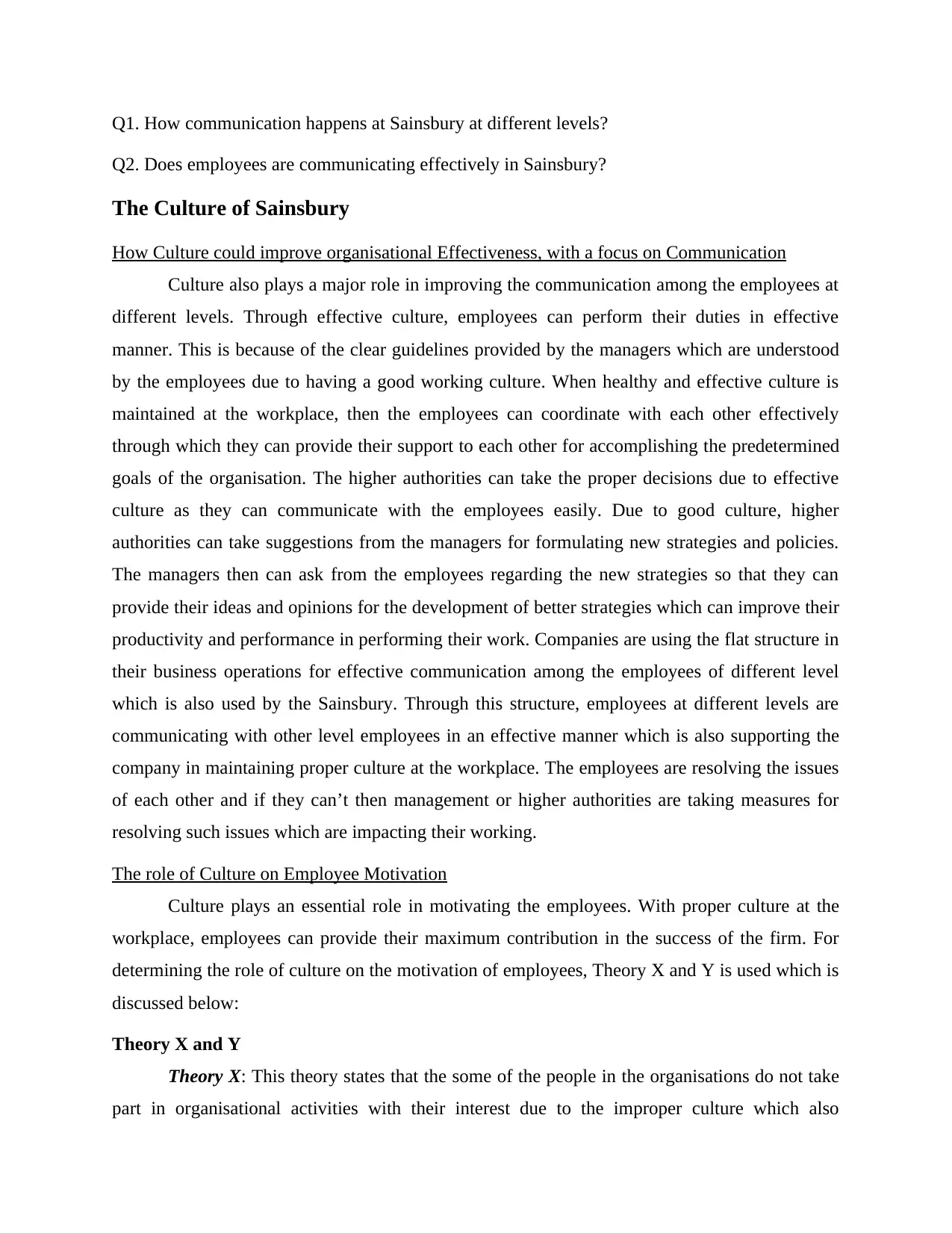
Q1. How communication happens at Sainsbury at different levels?
Q2. Does employees are communicating effectively in Sainsbury?
The Culture of Sainsbury
How Culture could improve organisational Effectiveness, with a focus on Communication
Culture also plays a major role in improving the communication among the employees at
different levels. Through effective culture, employees can perform their duties in effective
manner. This is because of the clear guidelines provided by the managers which are understood
by the employees due to having a good working culture. When healthy and effective culture is
maintained at the workplace, then the employees can coordinate with each other effectively
through which they can provide their support to each other for accomplishing the predetermined
goals of the organisation. The higher authorities can take the proper decisions due to effective
culture as they can communicate with the employees easily. Due to good culture, higher
authorities can take suggestions from the managers for formulating new strategies and policies.
The managers then can ask from the employees regarding the new strategies so that they can
provide their ideas and opinions for the development of better strategies which can improve their
productivity and performance in performing their work. Companies are using the flat structure in
their business operations for effective communication among the employees of different level
which is also used by the Sainsbury. Through this structure, employees at different levels are
communicating with other level employees in an effective manner which is also supporting the
company in maintaining proper culture at the workplace. The employees are resolving the issues
of each other and if they can’t then management or higher authorities are taking measures for
resolving such issues which are impacting their working.
The role of Culture on Employee Motivation
Culture plays an essential role in motivating the employees. With proper culture at the
workplace, employees can provide their maximum contribution in the success of the firm. For
determining the role of culture on the motivation of employees, Theory X and Y is used which is
discussed below:
Theory X and Y
Theory X: This theory states that the some of the people in the organisations do not take
part in organisational activities with their interest due to the improper culture which also
Q2. Does employees are communicating effectively in Sainsbury?
The Culture of Sainsbury
How Culture could improve organisational Effectiveness, with a focus on Communication
Culture also plays a major role in improving the communication among the employees at
different levels. Through effective culture, employees can perform their duties in effective
manner. This is because of the clear guidelines provided by the managers which are understood
by the employees due to having a good working culture. When healthy and effective culture is
maintained at the workplace, then the employees can coordinate with each other effectively
through which they can provide their support to each other for accomplishing the predetermined
goals of the organisation. The higher authorities can take the proper decisions due to effective
culture as they can communicate with the employees easily. Due to good culture, higher
authorities can take suggestions from the managers for formulating new strategies and policies.
The managers then can ask from the employees regarding the new strategies so that they can
provide their ideas and opinions for the development of better strategies which can improve their
productivity and performance in performing their work. Companies are using the flat structure in
their business operations for effective communication among the employees of different level
which is also used by the Sainsbury. Through this structure, employees at different levels are
communicating with other level employees in an effective manner which is also supporting the
company in maintaining proper culture at the workplace. The employees are resolving the issues
of each other and if they can’t then management or higher authorities are taking measures for
resolving such issues which are impacting their working.
The role of Culture on Employee Motivation
Culture plays an essential role in motivating the employees. With proper culture at the
workplace, employees can provide their maximum contribution in the success of the firm. For
determining the role of culture on the motivation of employees, Theory X and Y is used which is
discussed below:
Theory X and Y
Theory X: This theory states that the some of the people in the organisations do not take
part in organisational activities with their interest due to the improper culture which also
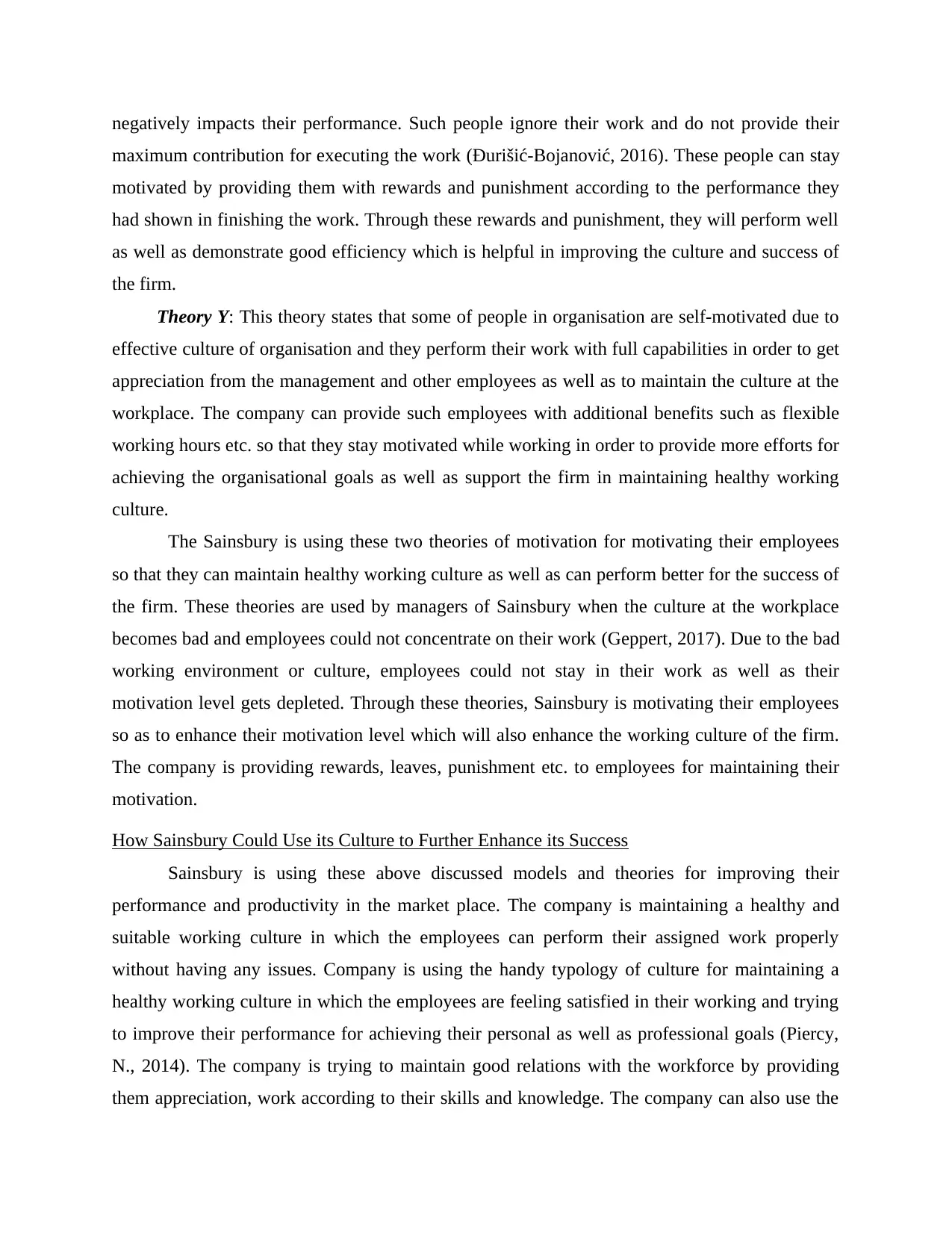
negatively impacts their performance. Such people ignore their work and do not provide their
maximum contribution for executing the work (Đurišić-Bojanović, 2016). These people can stay
motivated by providing them with rewards and punishment according to the performance they
had shown in finishing the work. Through these rewards and punishment, they will perform well
as well as demonstrate good efficiency which is helpful in improving the culture and success of
the firm.
Theory Y: This theory states that some of people in organisation are self-motivated due to
effective culture of organisation and they perform their work with full capabilities in order to get
appreciation from the management and other employees as well as to maintain the culture at the
workplace. The company can provide such employees with additional benefits such as flexible
working hours etc. so that they stay motivated while working in order to provide more efforts for
achieving the organisational goals as well as support the firm in maintaining healthy working
culture.
The Sainsbury is using these two theories of motivation for motivating their employees
so that they can maintain healthy working culture as well as can perform better for the success of
the firm. These theories are used by managers of Sainsbury when the culture at the workplace
becomes bad and employees could not concentrate on their work (Geppert, 2017). Due to the bad
working environment or culture, employees could not stay in their work as well as their
motivation level gets depleted. Through these theories, Sainsbury is motivating their employees
so as to enhance their motivation level which will also enhance the working culture of the firm.
The company is providing rewards, leaves, punishment etc. to employees for maintaining their
motivation.
How Sainsbury Could Use its Culture to Further Enhance its Success
Sainsbury is using these above discussed models and theories for improving their
performance and productivity in the market place. The company is maintaining a healthy and
suitable working culture in which the employees can perform their assigned work properly
without having any issues. Company is using the handy typology of culture for maintaining a
healthy working culture in which the employees are feeling satisfied in their working and trying
to improve their performance for achieving their personal as well as professional goals (Piercy,
N., 2014). The company is trying to maintain good relations with the workforce by providing
them appreciation, work according to their skills and knowledge. The company can also use the
maximum contribution for executing the work (Đurišić-Bojanović, 2016). These people can stay
motivated by providing them with rewards and punishment according to the performance they
had shown in finishing the work. Through these rewards and punishment, they will perform well
as well as demonstrate good efficiency which is helpful in improving the culture and success of
the firm.
Theory Y: This theory states that some of people in organisation are self-motivated due to
effective culture of organisation and they perform their work with full capabilities in order to get
appreciation from the management and other employees as well as to maintain the culture at the
workplace. The company can provide such employees with additional benefits such as flexible
working hours etc. so that they stay motivated while working in order to provide more efforts for
achieving the organisational goals as well as support the firm in maintaining healthy working
culture.
The Sainsbury is using these two theories of motivation for motivating their employees
so that they can maintain healthy working culture as well as can perform better for the success of
the firm. These theories are used by managers of Sainsbury when the culture at the workplace
becomes bad and employees could not concentrate on their work (Geppert, 2017). Due to the bad
working environment or culture, employees could not stay in their work as well as their
motivation level gets depleted. Through these theories, Sainsbury is motivating their employees
so as to enhance their motivation level which will also enhance the working culture of the firm.
The company is providing rewards, leaves, punishment etc. to employees for maintaining their
motivation.
How Sainsbury Could Use its Culture to Further Enhance its Success
Sainsbury is using these above discussed models and theories for improving their
performance and productivity in the market place. The company is maintaining a healthy and
suitable working culture in which the employees can perform their assigned work properly
without having any issues. Company is using the handy typology of culture for maintaining a
healthy working culture in which the employees are feeling satisfied in their working and trying
to improve their performance for achieving their personal as well as professional goals (Piercy,
N., 2014). The company is trying to maintain good relations with the workforce by providing
them appreciation, work according to their skills and knowledge. The company can also use the
⊘ This is a preview!⊘
Do you want full access?
Subscribe today to unlock all pages.

Trusted by 1+ million students worldwide
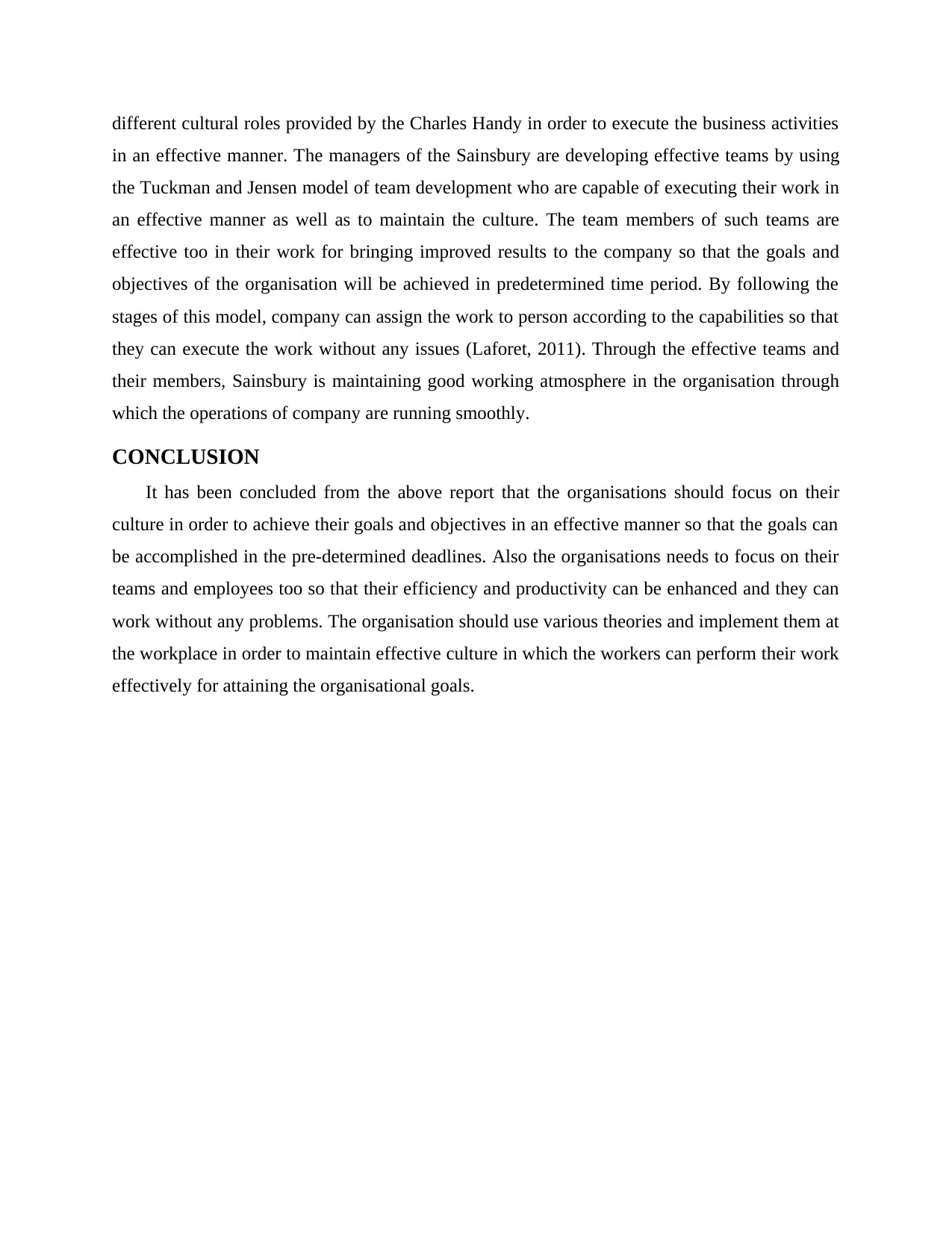
different cultural roles provided by the Charles Handy in order to execute the business activities
in an effective manner. The managers of the Sainsbury are developing effective teams by using
the Tuckman and Jensen model of team development who are capable of executing their work in
an effective manner as well as to maintain the culture. The team members of such teams are
effective too in their work for bringing improved results to the company so that the goals and
objectives of the organisation will be achieved in predetermined time period. By following the
stages of this model, company can assign the work to person according to the capabilities so that
they can execute the work without any issues (Laforet, 2011). Through the effective teams and
their members, Sainsbury is maintaining good working atmosphere in the organisation through
which the operations of company are running smoothly.
CONCLUSION
It has been concluded from the above report that the organisations should focus on their
culture in order to achieve their goals and objectives in an effective manner so that the goals can
be accomplished in the pre-determined deadlines. Also the organisations needs to focus on their
teams and employees too so that their efficiency and productivity can be enhanced and they can
work without any problems. The organisation should use various theories and implement them at
the workplace in order to maintain effective culture in which the workers can perform their work
effectively for attaining the organisational goals.
in an effective manner. The managers of the Sainsbury are developing effective teams by using
the Tuckman and Jensen model of team development who are capable of executing their work in
an effective manner as well as to maintain the culture. The team members of such teams are
effective too in their work for bringing improved results to the company so that the goals and
objectives of the organisation will be achieved in predetermined time period. By following the
stages of this model, company can assign the work to person according to the capabilities so that
they can execute the work without any issues (Laforet, 2011). Through the effective teams and
their members, Sainsbury is maintaining good working atmosphere in the organisation through
which the operations of company are running smoothly.
CONCLUSION
It has been concluded from the above report that the organisations should focus on their
culture in order to achieve their goals and objectives in an effective manner so that the goals can
be accomplished in the pre-determined deadlines. Also the organisations needs to focus on their
teams and employees too so that their efficiency and productivity can be enhanced and they can
work without any problems. The organisation should use various theories and implement them at
the workplace in order to maintain effective culture in which the workers can perform their work
effectively for attaining the organisational goals.
Paraphrase This Document
Need a fresh take? Get an instant paraphrase of this document with our AI Paraphraser
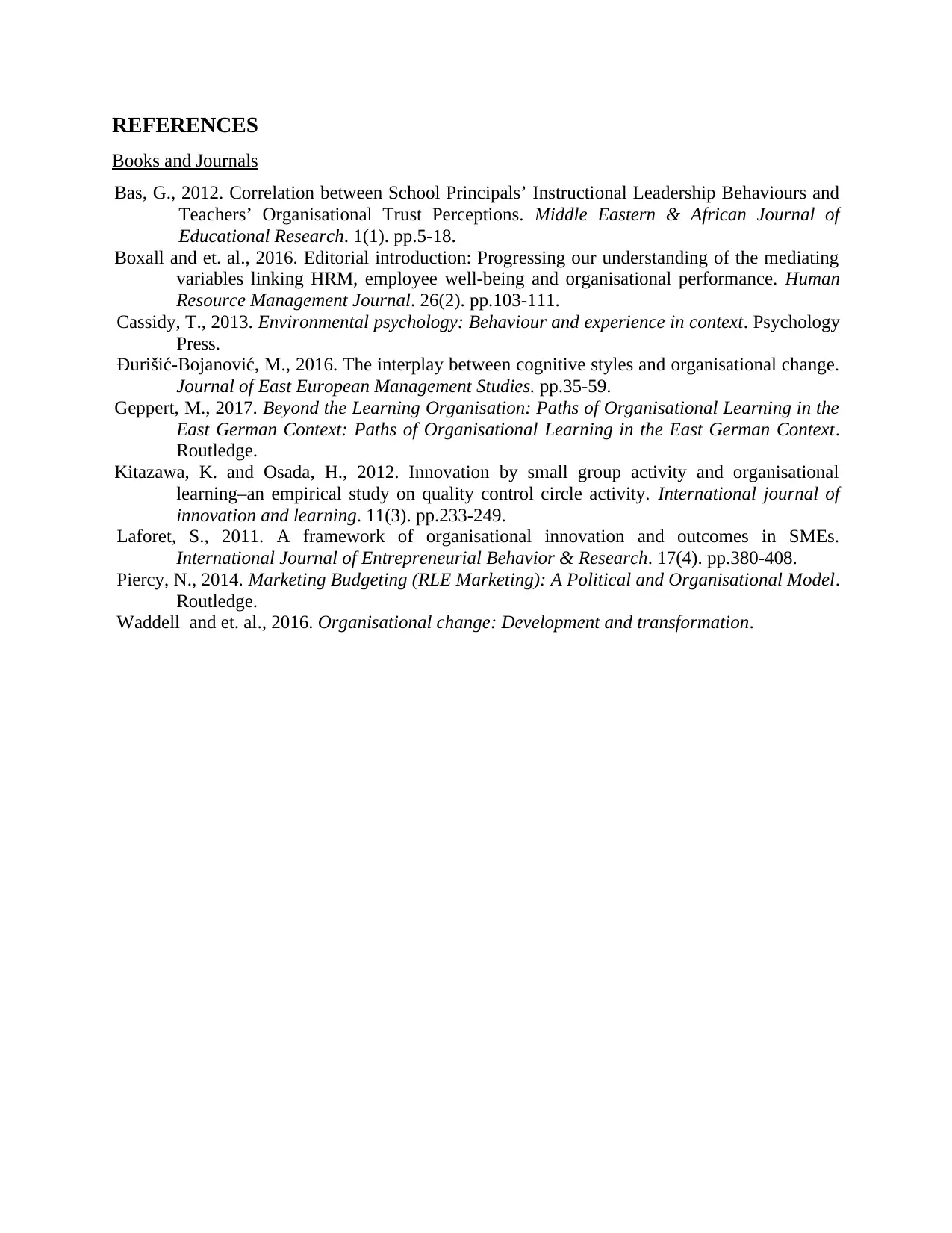
REFERENCES
Books and Journals
Bas, G., 2012. Correlation between School Principals’ Instructional Leadership Behaviours and
Teachers’ Organisational Trust Perceptions. Middle Eastern & African Journal of
Educational Research. 1(1). pp.5-18.
Boxall and et. al., 2016. Editorial introduction: Progressing our understanding of the mediating
variables linking HRM, employee well‐being and organisational performance. Human
Resource Management Journal. 26(2). pp.103-111.
Cassidy, T., 2013. Environmental psychology: Behaviour and experience in context. Psychology
Press.
Đurišić-Bojanović, M., 2016. The interplay between cognitive styles and organisational change.
Journal of East European Management Studies. pp.35-59.
Geppert, M., 2017. Beyond the Learning Organisation: Paths of Organisational Learning in the
East German Context: Paths of Organisational Learning in the East German Context.
Routledge.
Kitazawa, K. and Osada, H., 2012. Innovation by small group activity and organisational
learning–an empirical study on quality control circle activity. International journal of
innovation and learning. 11(3). pp.233-249.
Laforet, S., 2011. A framework of organisational innovation and outcomes in SMEs.
International Journal of Entrepreneurial Behavior & Research. 17(4). pp.380-408.
Piercy, N., 2014. Marketing Budgeting (RLE Marketing): A Political and Organisational Model.
Routledge.
Waddell and et. al., 2016. Organisational change: Development and transformation.
Books and Journals
Bas, G., 2012. Correlation between School Principals’ Instructional Leadership Behaviours and
Teachers’ Organisational Trust Perceptions. Middle Eastern & African Journal of
Educational Research. 1(1). pp.5-18.
Boxall and et. al., 2016. Editorial introduction: Progressing our understanding of the mediating
variables linking HRM, employee well‐being and organisational performance. Human
Resource Management Journal. 26(2). pp.103-111.
Cassidy, T., 2013. Environmental psychology: Behaviour and experience in context. Psychology
Press.
Đurišić-Bojanović, M., 2016. The interplay between cognitive styles and organisational change.
Journal of East European Management Studies. pp.35-59.
Geppert, M., 2017. Beyond the Learning Organisation: Paths of Organisational Learning in the
East German Context: Paths of Organisational Learning in the East German Context.
Routledge.
Kitazawa, K. and Osada, H., 2012. Innovation by small group activity and organisational
learning–an empirical study on quality control circle activity. International journal of
innovation and learning. 11(3). pp.233-249.
Laforet, S., 2011. A framework of organisational innovation and outcomes in SMEs.
International Journal of Entrepreneurial Behavior & Research. 17(4). pp.380-408.
Piercy, N., 2014. Marketing Budgeting (RLE Marketing): A Political and Organisational Model.
Routledge.
Waddell and et. al., 2016. Organisational change: Development and transformation.
1 out of 11
Related Documents
Your All-in-One AI-Powered Toolkit for Academic Success.
+13062052269
info@desklib.com
Available 24*7 on WhatsApp / Email
![[object Object]](/_next/static/media/star-bottom.7253800d.svg)
Unlock your academic potential
Copyright © 2020–2025 A2Z Services. All Rights Reserved. Developed and managed by ZUCOL.





